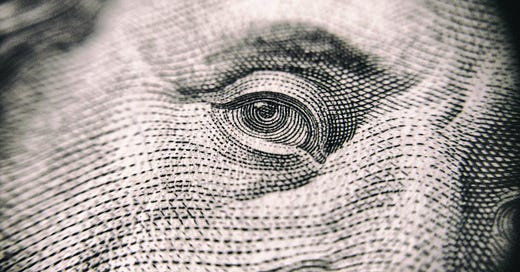Stablecoins are a gateway drug
They will allow bitcoin to subvert the dollar in monetary hierarchy.
Dear readers,
One year ago, January 18, 2021, Layered Money went live on Amazon. Today, I’d like to offer my first true addition to the book—an expansion of a vision of the future in which bitcoin, stablecoins, and central bank digital currencies (CBDCs) coexist.
The book spends only a brief time discussing stablecoins and how crucial they are in the explosion of bitcoin, both today and going forward. I’ll correct that here.
Monetary hierarchy
The US dollar is the world’s reserve currency, but what does the dollar represent? A dollar can be a piece of paper, a bank balance on your smartphone app, or shares in a money market fund (MMF). So exactly which dollar is the world’s reserve currency?
There is no straightforward answer to this question—banks, central banks, and governments all play their part. If the dollar has a combination of public and private issuers, its sanctity is only as good as the union of its creators. The Federal Reserve has assumed the role of the dollar’s singular guardian, because banks and the United States government have required bailouts—sorry, financing—from the Fed dozens of times over the past 15 years. The Fed calls it “providing liquidity,” but the Fed is the only institution that can literally create money without restriction, and the only one to save the union surrounding the dollar. The government cannot do this—Treasuries can only be issued within the confines of congressional and executive procedure. Banks cannot do this either—they must adhere to leverage ratios set forth by the Federal Reserve and other international standards such as the Basel Accords. The Fed alone can create unlimited liabilities by purchasing financial assets with newly created liabilities (of itself), called reserves. This is what the financial media calls “printing money,” but there’s no printing of paper notes involved in the QE process. Better to call it “digital reserve creation.”
Fed reserves are only available to banks, and the reserves are mostly created to purchase US Treasuries, creating a “backing” of the dollar that is often cited as the reason why the dollar is the world’s reserve currency. Yes, the US has the largest military budget and capabilities, but the dollar is more backed by the Fed’s willingness to support banks and the US government in any of their endeavors than by military dominance or by the oil trade. Today, the Fed’s power to do QE, or the creation of reserves by mandate, place it atop the hierarchy of dollar financial institutions.
Stablecoins
Stablecoins are a novel type of dollar because of their technological representation. But they aren’t novel from a monetary hierarchy perspective—they are a second- or third-layer money. Stablecoins are similar to bank deposits or MMF shares because they are backed by short-term fixed income assets, such as bank deposits themselves. Future regulations might mandate that stablecoin issuers own US Treasuries, in part, to back their coins. Any of these setups imply a position in the hierarchy right alongside today’s big players, banks and MMFs:

If stablecoins, regulated onshore or unregulated offshore, acquire the same level of dollar-ness as other second- or third-layer instruments throughout the dollar ecosystem, then stablecoins are just another dollar-type with credit risk that will ultimately be compared to the default risk of the US Treasury.
In that scenario, the demand for stablecoins will have only retail banking and MMFs as a ceiling, each currently storing trillions of dollars. Today, the market capitalization of stablecoins is a paltry $170 billion.
Stablecoins exist because of bitcoin
Tether (USDT) was created to allow BTC and USD to trade with less friction. Historically, dollars were very difficult to move around. Stablecoins modernized the movement of dollars by eliminating the banking rails and replacing it with a blockchain. Bitcoin’s architecture is modern and internet-derived, and Tether successfully made dollars more bitcoin-like. Tether enabled a better real-time snapshot of bitcoin’s price in dollar terms because of the ability to deposit and withdraw either BTC or USDT to or from cryptocurrency exchanges, achieving final settlement within minutes. Improved price discovery, thanks to stablecoins.
A gateway drug
In the classic example of financial crisis and monetary hierarchy, the holder of a gold certificate rushes to the bank to demand physical gold coins when faced with the prospect that his issuer is a credit risk. The second-layer money (paper certificate) is useless if the issuer defaults, only the first-layer gold coin is money in a default scenario. What happens when a stablecoin defaults?






